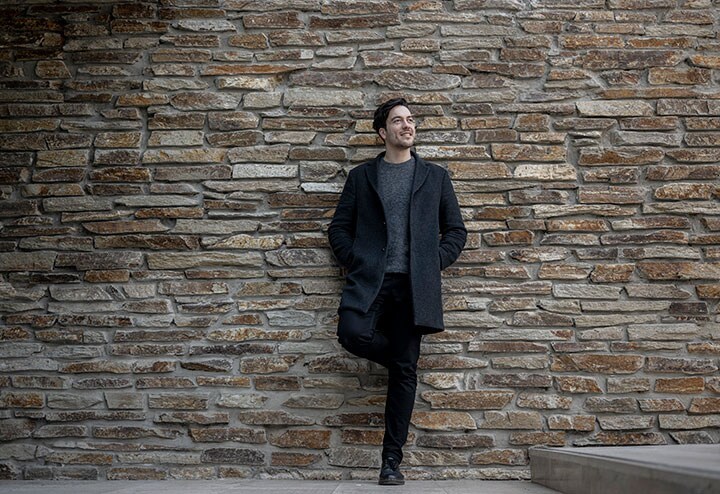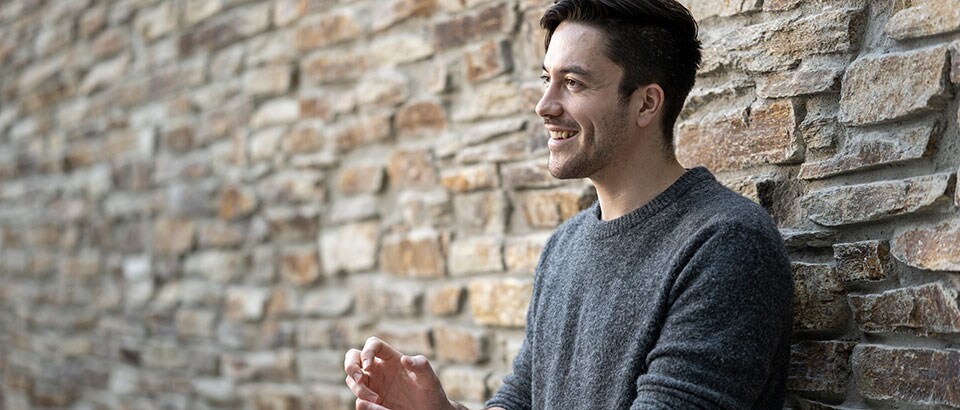Philips heeft stevige ambities op het gebied van duurzaamheid. Een voorbeeld: in 2025 moet 25 procent van de omzet komen uit circulaire producten, diensten en oplossingen. Ook moet er in dat jaar een inruilaanbod gelden voor alle professionele medische apparaten - om zeker te zijn van een verantwoord innamebeleid aan het einde van de levenscyclus.
Er zijn al veel succesvolle initiatieven die bijdragen aan die doelstellingen. Zo krijgt medische apparatuur een tweede leven door het refurbishen van medische apparaten en hergebruik van onderdelen. Ingenieur Cameron Watson is onderdeel van een team dat afdelingen van Philips helpt om deze circulariteitsdoelstellingen te behalen.
Zijn achtergrond als ingenieur komt daarbij goed van pas. Maar de echte doorbraak zit volgens Cameron in een andere manier van denken: wie circulaire producten of diensten aan wil bieden, moet het hele verdienmodel opnieuw tegen het licht houden.

Enorme schaal van voedselproductie
Het zaadje voor zijn huidige rol werd al jaren geleden geplant, toen hij voor zijn werk voedselfabrieken bezocht over de hele wereld. “Aan de ene kant stond ik versteld van de efficiëntie, aan de andere kant schrok ik van de enorme hoeveelheden voedsel en verpakkingen die werden geproduceerd. Ik herinner me nog dat ik in een kleine kippenfabriek in Rusland zag hoe elke dag een half miljoen kippen werden verwerkt. In Engeland stond ik oog in oog met productielijnen in die meerdere zakken chips per seconde uitspuugden. Als je zoiets ziet, dan word je je pas bewust van de enorme schaal van de voedselproductie. In mijn hoofd zag ik een net zo grote stapel niet-recyclebare verpakkingen aan het andere eind van die consumptieketen.”
Als Sustainability Innovation Management Consultant werkt hij nauw samen met verschillende afdelingen binnen Philips om manieren te vinden om producten en diensten naar een hoger niveau van circulariteit te tillen. “Ik vervul vooral de rol van projectontwikkelaar en manager van kleine, pragmatische projectteams. Er zijn veel manieren waarop we helpen; we analyseren trends, voeren benchmarks uit, werken visies uit en beoordelen productontwerpen.”
Huwelijksadviseur tussen technologie en commercie
In zijn rol komt zijn technische achtergrond goed van pas. “Als ingenieur in een adviserende rol voel ik me vaak een huwelijksadviseur, een bemiddelaar tussen technische en commerciële stakeholders. Oplossingen voor duurzaamheidsambities worden vaak gezocht in nieuwe technologieën of ontwerpkeuzes. EcoDesign, of productontwerp voor circulariteit is een populair voorbeeld; we krijgen vaak de vraag om mee te denken over een productontwerp met onderdelen die hergebruikt kunnen worden.
Maar juist ook in de commerciële benadering liggen grote kansen. Het gaat vaak om het compleet opnieuw uitvinden van een verdienmodel en de relatie die je hebt met je klanten. Zo kun je overschakelen van de verkoop van producten naar een abonnementsmodel. Voor de klant verandert er niet zo veel; die blijft toegang krijgen tot een product, maar het eigendom blijft in handen van de aanbieder. Dat maakt het veel makkelijker om het product terug te nemen aan het einde van zijn levenscyclus en de kringloop rond te maken, door het hergebruik van producten en onderdelen.”

Een ander goed voorbeeld van een circulair model is de deeleconomie: “Als je erover nadenkt, is het een van de oudste ruilmodellen ter wereld. Onze samenlevingen hebben millennia lang op deze manier gefunctioneerd. Dat is verschoven tijdens de Industriële Revolutie, toen er steeds meer betaalbare producten op de markt kwamen en consumenten in toenemende mate konden kopen wat ze wilden.
Daardoor zitten we nu in een situatie waarin het eigenlijk heel logisch lijkt om iets goedkoops aan te schaffen, voor korte tijd te gebruiken en dan weg te gooien. De essentie van circulariteit is dat we daarvan af moeten. Dat vereist dat we onze lineaire ecosystemen overboord gooien en gaan kijken naar alternatieve commerciële strategieën.”
Het geheime ingrediënt van circulair ondernemen
Het geheime, zo niet belangrijkste ingrediënt, volgens Cameron: “Het komt altijd neer op systeemdenken. Probeer je niet blind te staren op specifieke problemen en oplossingen, maar kijk naar onderlinge samenhang tussen componenten van een systeem. Hier ontstaan vaak doorbraken in onze projecten; het moment waarop je je realiseert dat jouw product of dienst deel uitmaakt van een groter circulair ecosysteem. Dat betekent bijvoorbeeld dat je ook moet nadenken over hoe je producten en onderdelen terug kunt nemen, hergebruiken hoe je daarover met klanten moet communiceren.”
Als je je realiseert dat alles met elkaar verbonden is en dat alle beslissingen gevolgen hebben voor het ecosysteem, dan ben je je ook bewust van het feit dat we het allemaal samendoen, aldus Cameron: “Veel organisaties proberen het op eigen houtje te doen om de concurrentie voor te blijven. Die zien de voordelen van samenwerking en het delen van kennis in een evoluerend circulair ecosysteem over het hoofd. Als alle organisaties in volstrekte isolatie hun eigen circulaire oplossingen blijven ontwikkelen en hun eigen ecosystemen blijven creëren, dan zal te transitie naar een circulaire economie langzaam verlopen. Een goed voorbeeld is opladers voor laptops en mobiele telefoons; er is echt geen reden waarom er in de eerste plaats zoveel verschillende soorten opladers zouden moeten zijn ontwikkeld.
We hebben organisaties nodig om samen te komen en samen te werken, en facilitators om een bredere ontwikkeling van ecosystemen mogelijk te maken. We moeten samenwerken om dit voor elkaar te krijgen.”

An engineering perspective on circularity: “You have to look at the entire ecosystem, stay away from individual problems and solutions”
Philips has serious ambitions when it comes to circularity. In 2025, 25 per cent of revenue should come from circular products, services and solutions. On all professional medical equipment, a trade-in should be offered to manage end of-use responsibly.
Many initiatives are already very successful, like giving medical equipment a second life through refurbishment and re-using parts. With a background in engineering, Cameron Watson is part of a team that helps businesses within Philips to achieve these circularity targets.
It is often not only the technical advice that creates innovative breakthroughs though: going circular often means rethinking your entire business model.

Many ways to help
The seed for his current role was planted years ago, in a previous job, in which he visited food factories all over the world. “I was at the same time amazed by the efficiency and horrified at the volumes of output food and packaging. I remember being in a small chicken factory in Russia, seeing how half a million chickens were processed every day. Seeing crisp production lines in the UK, each spitting out finished packets faster than a bag per second, really brought home the sheer scale of production. I couldn't help imagining the piles of empty unrecyclable packets growing at the same rate on the other end of the consumption chain.”
As a Sustainability Innovation Management Consultant, he works closely together with businesses within Philips to find ways to increase their level of circularity. “I mainly take the role as project creator and manager with small, hands-on project teams. There are many ways in which we help; from high-level trend analyses, benchmarks and visioning to very specific design assessments.”
Marriage counselor between technology and business
This is where his background comes in handy. “As an engineer in a consultancy role, I often feel like a marriage counselor, as a mediator between technical and commercial stakeholders. Businesses regularly turn to novel technologies for solutions to their sustainability ambitions, as well as to design; we are often asked to think about how a product can be designed in such a way that parts can be repurposed after use.
But significant opportunities also lie in the commercial approach, such as in rethinking business models and the types of relationship an organization has with its customers. This includes approaches such as changing the sales focus from physical products to the enabled customer experience or goals through subscriptions. The ownership of physical assets remains with the producer which ensures that the loop is closed, allowing the experts to triage and responsibly repurpose products and parts.”

Another good example of a circular-supporting commercial model is the sharing economy: “When you think about it, it is the oldest business models in the world. This is how our societies have functioned for millennia. This seems to have shifted with the Industrial Revolution as affordable product availability exploded and consumers have been increasingly able to have everything they want, all the time. As a result, we are now in a situation in which it seems justifiable to purchase something cheap, use it for a short period of time, and then throw it away. The essence of circularity lies herein; we need to break out of this take, make, waste mentality. Doing so requires rethinking elements of entire mature linear ecosystems, considering alternative commercial frameworks, enabling and supporting technologies, and nurturing social change to allow them to flourish in a linear-dominated market.”
The secret ingredient of circular business
The secret, if not most important ingredient, according to Cameron: “It always comes down to systems thinking; trying not to get blinkered in only narrow and targeted problems and solutions but looking at the relationships and orchestration between components of a system. This is where breakthroughs in our projects often occur, when you realize how what you are working on fits as part of a larger circular ecosystem. Rethinking business in a circular way requires looking at the complete picture, before looking at the practical circular actions such as redesigning a product to make sure that parts can be recycled. “You always need to carefully consider everything; how to take back assets and materials, recover parts, and how to communicate effectively and clearly with customers.
Remembering to think in terms of the ecosystem when challenged with an individual component or process helps remind us that everything is connected and decisions have implications beyond initial narrow scopes. This is an important reminder that we're all in this together, according to Cameron: “Many organizations try to do it alone for competitions' sake and overlook the inherent requirement for partnerships and knowledge sharing in an evolving circular ecosystem. If all organizations continue to develop their circular solutions in isolation and create exclusive or partial ecosystems, it may slow the overall transition to a circular economy. An example can be seen with electronic device charging ports requiring different cables and leading to excessive numbers of chargers and cables in consumers’ homes.
We need organizations to come together and collaborate, and facilitators to enable broader ecosystem development. We must work together if we are to make circularity a mainstream reality.”












